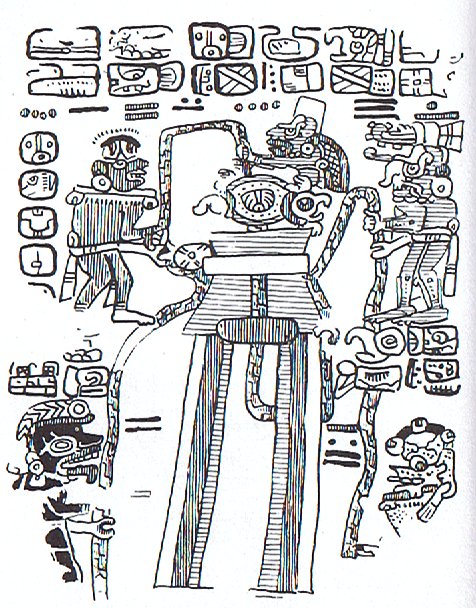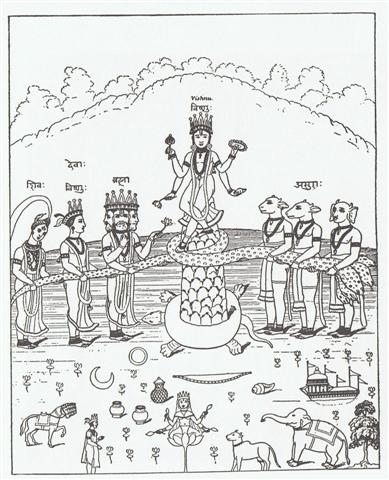|
TRANSLATIONS
I propose the following. We should count the months in our own calendar on the fingers (or knuckles) of the left hand. Before we begin with January, however, a 13th special month - belonging to the previous year - can be imagined. (In Sweden we celebrate Lucia on December 13.) Sun is male and moon female until you arrive far up in the north, where for example the Inuit people consider sun to be famale and moon male - it is more important in the polar night to have the moon shining when you are out hunting on the ice. Lucia is the female counterpart of the male lightbringer Lucifer. January is the last and first true month of the calendar, and it corresponds to Sunday in the week. Before Sunday there is an absent abolished 8th day (which though the Dogon people remember). Let us make it all clear in a table and let us begin with the days of the week in the first column:
Sorted with the erased 8th valley at the end of the cycle, it becomes clear that we have arrived at the hinge between the cycles, at Te Pei. There are no more than 7 days in our week. We have erased the 8th day together with the 13th zodiacal sign, the Serpent. In our civilizated and well-ordered world we do not want to be remembered of who the leading limb really is. Not even before the Victorian days. In the Old World (Eurasia) there is only water in the lower part of the cycle of the single year, nothing to map there. In the New World (to which Polynesia culturally belongs) there are two equal wheels, and the fortnight still is the measure, not the week. Let us now put Ka4-11--12 into focus. It is located some 160 days after the beginning of the calendar.
Mago at 81 has days 161-162 (close to 5.5 * 29.5 = 162.25). If we take away 24 glyphs (those in glyph line a1), we have 81 - 24 = 57 glyphs = 114 days, or close to 4 months. (4 * 28.5 = 114.) If we instead count from Rei in Ka3-15 mago will come as number 81 - 41 = 40 (or 80 days later). But I want Ka4-11 to be in March (Mars), because that would agree for instance with the beginning of side a in Tahua:
It can be imagined that Sun, Moon, and Mars came first - Mars with two glyphs because of his two faces (close and far away, as if moving far away in order to fetch down the fire to the earth). ... During his descent the ancestor still possessed the quality of a water spirit, and his body, though preserving its human appearance, owing to its being that of a regenerated man, was equipped with four flexible limbs like serpents after the pattern of the arms of the Great Nummo. The ground was rapidly approaching. The ancestor was still standing, his arms in front of him and the hammer and anvil hanging across his limbs. The shock of his final impact on the earth when he came to the end of the rainbow, scattered in a cloud of dust the animals, vegetables and men disposed on the steps. When calm was restored, the smith was still on the roof, standing erect facing towards the north, his tools still in the same position. But in the shock of landing the hammer and the anvil had broken his arms and legs at the level of elbows and knees, which he did not have before. He thus acquired the joints proper to the new human form, which was to spread over the earth and to devote itself to toil ... With fire comes light and order to the dark primeaval chaotic world. There is a theft of fire, a chase leading from afar down to earth. The fire of the smith also leads to an ordered world with limbs defined by elbows, knees, and knuckles. Measurements. But in spring Mother Nature evolves in astonishing speed, keeping up with the evolving order robbed from the sky. Speed causes disorder, which is a frightening phenomenon. Only at midsummer can raw nature be tamed ('cooked'). The struggle is a kind of tug of war, where the dark spring forces compete against the light forces of ordered human society:
(Hamlet's Mill) High in the center the serpentine rope goes straight down through the turtle resting upon the roof.
(Hamlet's Mill) Here Vishnu is at the top and turtle at bottom. It is not the precession we see (which is suggested in Hamlet's Mill), it is the struggle of the light forces of order against the black forces of nature. The animal heads characterize the black spring side. The picture should be reversed because they should be at left (in the east), or possibly the hourglass has been turned upside down (the turtle is at bottom) switching the animals from the left to the right side. The Q tail of the turtle is on their side, the serpent is an animal. The Mountain in the background must be in the north, which means the picture presumably illustrates the situation in midwinter, the 2nd halfcycle of the year is at left. Janus has three faces, not two. He has 5 'flames' in his hair. The preceding figure has 3. Together 8. |
||||||||||||||||||||||||||||||||||||||||||||||||||||||||||||||||||||||||||||||||||||||||||||||||











